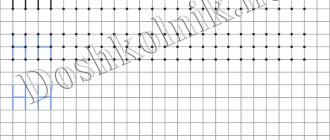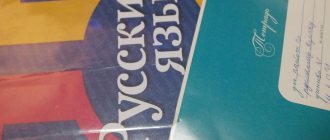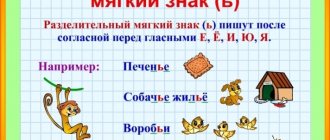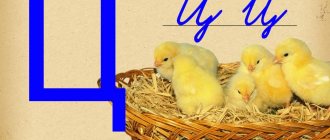Today the letter Y is with us.
An interesting analogy: a person who wants to isolate himself (put himself first), as a rule, says left and right: “I did this…. I am so and so... I... I... I...".
And those listening to him with a grin (well, or with indignation) snapped: “I am the last letter in the alphabet .
What do they mean by this?
But they want to say that you should not stick your head out with your omnipresent “I”, because you need to be quicker in life.
And I decided to get to know “I” better. I learned a lot of interesting things about her, so I decided to introduce you to her.
When did the removal of letters from the alphabet begin?
During the period of Soviet power, it was decided to move the letter “Ya” to the last place, since “Izhitsa” was practically no longer used by that time.
Only in church texts could one see it. It is interesting that the Bolsheviks did not react to the removal of Izhitsa from the alphabet; then it seemed to everyone that the authorities had decided to simply abandon one of the sacraments - confirmation.
After all, Izhitsa was used in the word “mirro”. And having abandoned the letter that is part of this word, it seemed to many that the very giving of the gifts of the Holy Spirit was abolished as a means of strengthening his spiritual life.
The removal of “Izhitsa” was not documented, but the elimination of “fita” became the final appointment of the letter Ya as the final letter of the Russian alphabet.
Peculiarities of use in foreign words
The soft dividing sign (the rules of use are given in the next section) will not give two sounds to the letter in all cases. After all, if we take the word “battalion” as an example, we can see that the letter “o” has one sound of the same name, and the sign only gives the “n” softness. However, “ь” is still a separator, since it is in the middle of the word. However, this feature is observed only in those words that were originally borrowed from another language. Here are some interesting examples:
- pavilion;
- cotillion;
- canyon;
- postman;
- champignon;
- medallion;
- bouillon.
We recommend reading: The Psychology of Writing
For the Russian language, the use of “ь” before the vowel letter “o” is atypical, therefore, in almost all cases, in this way one can almost accurately determine where in the text a word borrowed from a foreign language is located. This can be called the unspoken fourth role of this interesting letter.
However, we should not forget that Russian spelling can change over time, so the list of borrowed words becomes more extensive every year.
Pronunciation and spelling of "I"
If we listen to the sound of the letter and pronounce it for a long time, we will hear the following sounds [y-a-a-a-a-a-a].
If a letter stretches when sounded, it is a vowel.
The letter I consists of two sounds, a short consonant sound [th] and a vowel sound [a], and it can be sung. This sound feature is called iotation.
I = [й′] [a] - this is how the sounds included in the letter I are designated in transcription.
We see that there is one letter, and there are two sounds in it, one of which Yot is a consonant. In writing it is designated as Y, which is why it is called iotized.
At the beginning of a word or after vowels and separators, we hear the consonant J, and then the vowel sound A.
After consonants, I often softens them: blunder. Here L is pronounced softly thanks to Ya.
But this is only if “I” is in the position of a stressed syllable.
In the unstressed position, “I” seems to repeat the sounds E and I: fields - field.
If I is heard after hissing (ch, sch, sh, zh), guttural (x, g, k), after c, this does not mean that it is written after them. Not at all. We write “a” in these cases.
This rule does not apply only to foreign words, such as: Siauliai, Djakovitsa, Mkrtchyan, etc. Here we write “I” even after sibilants.
The letter “I” in a word is a separate syllable, in a sentence it is an independent word. In some cases, the letter I appears as a whole sentence, for example:
— Who will go to the museum next week?
- I!
The role and meaning of the soft sign in Russian
The separative b is used in the root of a word between its parts. As already mentioned, in Russian ь has no sound, but performs three main functions.
Such as:
- An indicator of the softness of a consonant.
- Indicator of grammatical form (3rd declension feminine or infinitives answering the question “what does / what to do?”).
- Separating a consonant from the vowel that follows it.
Often, people know only one function - an indicator of softness, because of this, mistakes are made in words such as, for example, “article” or “blizzard”.
Poems about the letter I
This letter is clear, bright, beautiful. My letter loves all the words where the letter I is.
Both at the beginning and at the end: Both on the Yacht and in the Egg. In the fields - here in the middle. Ali has it, Nina doesn’t.
Look carefully - the letter is interesting!
***
The letter I lived in an egg. At the beginning of the word, not at the end. And then, such a thief, multiplied in the word “Lala”.
All vowels survived. And there are consonants nearby. In “lyalya” I got used to it, I became friends with the consonant L.
***
Audio poem about the letter I
Examples of words with a soft sign
It is easiest to understand any rule using a specific example. Let's consider in which words the soft sign is used in the middle (root) of the word, and in which at the end.
In the middle of a word
- curious;
- serious;
- pedestal;
- computer;
- interior;
- barrier;
- bindweed;
- play;
- weeds;
- canyon;
- bouillon;
- nightingale;
- passerine;
- clerk
At the end of a word
- trees;
- feathers;
- family;
- studio;
- dress;
- arsenic;
- all-around;
- interview;
- fun;
- shreds;
- branch;
- rags;
- draw.
Now you know in which cases you need to write a separating soft sign, and in which not. At the beginning of studying this topic, it is better to pronounce the word in your head, and if you hear it as if it is divided into two parts, check it with the rules presented above.
Subsequently, the use of soft separating characters in words will become automatic and will no longer seem such a difficult task.
The word on the soft sign begins: example
The word on the soft sign does not begin
It's no secret that each letter of the alphabet corresponds to a certain sound. But in the Russian alphabet there are difficult letters that do not have a sound, and they also do not indicate it. One of these letters is the separating soft sign. When written, it looks like this - “b”. As a rule, a soft sign is located after a consonant, and nothing else, and is intended to soften it.
One of the requirements for writing a soft sign is that it cannot be written after prefixes, or at the beginning of words. That is why, in the Russian language, there are no examples of words beginning with a soft separating sign.
Possessive adjectives
Among the examples of “ь” there are often words that are formed by declension and placing possessive adjectives in indirect cases. However, it is worth remembering that this part of speech may not be inclined in all cases. Although in the Russian language you can still find several interesting words that will lend themselves to this rule, for example, “Cossack”. If you try to inflect a possessive adjective, you will see the following picture:
- nominative - Cossack;
- genitive - Cossack;
- dative - Cossack;
- accusative - Cossack;
- instrumental - Cossack;
- prepositional - about Cossack;
Particular attention should be paid to the dative, instrumental and prepositional cases, because it is in them that, in most cases, novice writers make common mistakes, simply forgetting that it is necessary to put “b”. However, it is worth understanding that not all possessive adjectives can decline, and even more so, the root will not always include the letter that must be preceded by “b”.
How not to make a mistake when writing a soft sign in the middle and end of a word?
A soft sign at the end of a word is needed to soften the consonant in front.
We recommend reading: The complete version of time management for writers and freelancers
Examples: coal, salt, moth, tulle, pain, daring, calm, scrap, teacher, password.
The sounds ch, zh, sh, according to the canons of the Russian language, cannot be soft a priori, but in some cases a soft sign can be placed after them. It does not soften the preceding consonant, but is needed to preserve the grammatical form. Let's see in what cases this can happen:
- Feminine nouns (rye, quiet, mouse).
- Verbs in all forms (drain, protect, build, wash).
- In adverbs ending in ch and sh (backwards, completely) and in one adverb ending in w (wide open).
When you don’t need to put a soft sign after hissing ones:
- Masculine nouns (reed, garage, guard).
- Short adjectives (good, nice, fresh).
- Adverbs with except wide open (unbearable, married, already).
- Feminine nouns in the plural of the genitive case (pears, clouds, heaps).
Algorithm for self-test
In order to learn to correctly distinguish words with dividing marks (hard and soft), as well as softening letters, you should analyze several examples in practice, using a certain algorithm of actions. Here is a short guide that will be especially useful for beginning writers and middle school students:
- Write the word down on your notebook and pick up a pencil.
- Take a look at the characteristics of the word and its role in the sentence.
- Determine the part of speech using a question and the meaning of the construction.
- Carry out morphemic analysis, trying to modify some or other parts (root, suffix, prefix).
- Be aware of possible exceptions.
- Draw conclusions and write the correct letter.
As practice shows, students remember the rules much faster if they have completed some tasks designed to reinforce the material. So it’s worth examining one or two interesting examples in practice using the described algorithm of actions. You can even do the exercise with two words at once to make it more interesting: “exhausted” and “hookah”:
- Having written out the examples in a notebook, you must first determine the part of speech. The first is a participle, the second is a noun.
- Next, you need to analyze the composition to determine where the words end and the prefixes begin. In the case of “hookah”, everything is more or less simple - the root is the entire word. But the first example can cause difficulties. Although it is enough to remember what participles are formed from - “to ride” - that is, the root is “ezh” (alternation occurs, then comes the standard suffix “enn”, and the prefix “iz” comes in front).
- According to the rules, it is necessary to write a hard separator in the first example, and a soft one in the second.
- Words are also no exception.
Finding the separating “b” is not as difficult as it might seem at first glance. The most important thing is to remember what the rules say and also practice as much as possible with different examples. In this case, even the most cunning designs will not be able to confuse the writer.
Exception words with a soft separator
In native Russian words, the separating soft sign occurs only before the vowels e, ё, yu, ya, i. But in foreign words (especially French) it can appear before the letter o:
- postman;
- bouillon;
- medallion;
- canyon;
- cotillion;
- battalion;
- pavilion;
- companion.
Let's remember! When transferred, the separating soft sign remains on the previous line: monkey-yana, curious.
A little about the transfer
How to hyphenate words with a soft sign in the middle of a word? This is worth considering separately. Words with a soft sign in the middle of a word often cause difficulties when you need to move the word to another line. And there are many mistakes of this kind made in the texts.
Words with a soft sign in the middle are hyphenated as follows: first, you need to divide the word you want to hyphenate into syllables. We remember that, as many vowels in a word, there are as many syllables.
Step 1. Example: oh-no-me.
It is important to remember that when transferring a word with a separating soft sign to another line, you cannot separate the soft sign from the consonant in front - the transfer must be carried out only with it.
Step 2. Example: monkey-yana (example of correct transfer).
An important detail: if a soft sign is located at the end of a word, it cannot be moved to another line.
Incorrect example: mother-in-law, love, bear.
Correct example: father-in-law, love, honey.
When hyphenating, you cannot leave one letter on a line. This rule applies not only to words with a soft sign in the middle of the word, but also to any others.







